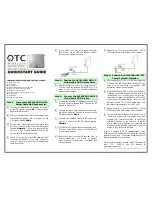
Configuration / project engineering
5.6 Configuration with Web Based Management
SCALANCE W786-xPRO
Operating Instructions, Release 08/2007, C79000-G8976-C221-02
143
The eight columns of the port table show the following information:
●
Port
Specifies the ports to which the information relates. WLAN1 VAP2, for example, relates to
the virtual access point VAP2 on the first WLAN interface.
●
Priority
You set the priority of the ports of a bridge with this parameter.
If the path calculated by spanning tree is possible over several ports of a switch, the port
with the highest priority (in other words the lowest value for this parameter) is selected. A
value from 0 through 240 can be specified for the priority; the default is 128.
●
STP Cost & RSTP
These parameters are used to calculate the path that will be selected. The lower the
value, the greater the probability that the corresponding path will be used. If several ports
of a bridge have the same value, the port with the lowest port number will be selected.
Depending on whether STP or RSTP was selected as the version, the value of STP Cost
or RSTP Cost will be used.
The calculation of the path costs is based mainly on the transmission speed. The higher
the achievable transmission speed, the lower the value for Path Cost should be.
Typical values for spanning tree and rapid spanning tree are as follows:
(The values can, however, also be set individually.)
Data rate
Path costs STP
Path costs RSTP
100 Mbps
19
200.000
54 Mbps
33
370.370
48 Mbps
36
416.667
36 Mbps
43
555.556
24 Mbps
53
833.333
18 Mbps
58
1.111.111
12 Mbps
83
1.666.667
11 Mbps
90
1.818.182
10 Mbps
100
2.000.000
9 Mbps
111
2.222.222
6 Mbps
166
3.333.333
5.5 Mbps
181
3.636.364
2 Mbps
500
10.000.000
1 Mbps
1000
20.000.000
●
Edge
The following entries are possible in the this column.
yes There is an end device on this port.
no There is a spanning tree or rapid spanning tree device on this port.
If an end device is connected, a SCALANCE X-700 can switch over the port more quickly
without taking into account spanning tree frames. If a spanning tree frame is received
despite this setting, the port automatically changes to the no setting for further stations.
Note
If clients with the layer 2 tunneling function enabled connect to the access point, a
separate port is opened for each of these clients. These ports cannot, however, be
configured for Rapid Spanning Tree. The settings (for example, priority and path costs
etc.) of the cell over which the client is connected to the access point are adopted.
















































